Collapse of the wave function is the transformation from a spread-out wave function to a localized particle. To understand this phenomenon, one must understand the meaning of “wave function,” which is described in its own article.
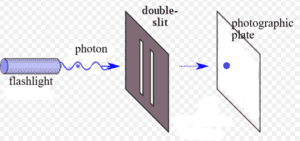
The wave function is the equation which describes the changing or “evolving” photon. It is an equation which derives from the Schrodinger Equation. Sometimes, scientists describe the wave function as if it were not only an equation but also a real physical object. However, this approach leads to difficulty in understanding the physical meaning of quantum mechanics. It’s more straightforward to consider the wave function as no more than an equation.
In our example, the wave function describes the evolution of the photon. But it is not telling us the trajectory of the photon. Rather, it is telling us the evolving probabilities of where we would find it if the photon were to be detected. The wave function might tell us at any one moment that there’s a 20% probability of the photon landing at this spot on the photographic plate, a 30% probability there, a 40% probability there, and a 10% probability there on the plate. The probabilities total 100% as this experiment has been set up so that there’s a 100% chance that we’ll find the photon somewhere on the photographic plate.
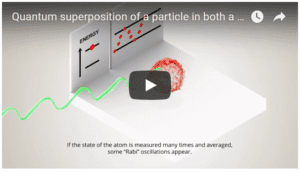
The accompanying animation shows a different example of wave function collapse. An entire atom rather than a tiny photon is shown. The animation shows a superposition of two possible energy levels that the atom might adopt. These energy levels are shown as if they are real physical things. But they are possibilities described by the wave function and not part of our physical reality. The video gives substance to the possibilities described by the wave function in order to better communicate. When the atom interacts with an object (is “measured”), the wave function collapses. Upon collapse, the atom is measured as having one of the two possible energy levels. In this animation, the collapse of the wave function is called “decoherence.” More about decoherence in a later section of this article.
Collapse of the Wave Function
Getting back to the photon shot from the laser gun. Soon enough, the photon is detected as a little dark dot on the photographic plate. Physicists would say that it has been “measured.” “Measured” really means that the photon has had an interaction with something in the physical universe. This interaction allows us to detect the photon. In this case, the photon is absorbed by an electron in the photographic plate, which creates a dark spot on the plate. Upon measurement, that is, this interaction, the probabilities calculated by the wave function instantaneously convert to a 100% probability for the specific dark spot and 0% everywhere else. The wave function has “collapsed.”
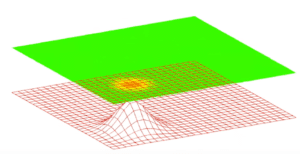
Nor does the wave function calculate the position in which the photon will leave its mark. The selected position appears to be random. Physicists must “write in by hand” the detected position of the photon rather than being able to calculate it.
The failure of the wave function to describe what happens when the photon interacts with the physical universe and is detected is called the “Measurement Problem.” This is the problem that the Schrodinger Cat thought experiment (as described below) was designed to highlight. The Measurement Problem has additional aspects including an inability to rigorously define “measurement.” In the Copenhagen Interpretation, the interpretation that this article focuses on, measurement is defined in a general way as the quantum particle interacting with a macroscopic object. The Copenhagen Interpretation, itself, provides no mathematical description of this interaction. However, other interpretations do. And the theory of decoherence when added to the Copenhagen Interpretation also provides a mathematical description of the interaction.
Wave Function Collapse and the Speed of Light
Yet another aspect of the Measurement Problem is that wave function collapse appears to violate the speed limit of the universe, the speed of light. Albert Einstein and two colleagues pointed this out in a famous paper, nicknamed “The EPR Paper” for the last names of the three authors. As noted above, when the wave function collapses, all positions except one instantaneously adopt a probability of 0%. One position, the position in which the photon is detected, adopts a probability of 100%. How can all the other positions described by the wave function instantaneously get the news that the photon has just been detected in one position? The conversion of the probabilities appears to be instantaneous, and “instantaneous” is faster than the speed of light. This violates the Special Theory of Relativity, a theory well-confirmed by empirical observations.
In this description of the wave function, it violates “locality.” Locality is the principle that objects are affected only by those things which touch it. And anything that can touch something else must not exceed the speed of light. Even when we hear a radio broadcast of a symphony created half-way across the world, locality is preserved. The sound has traveled as vibrations of air molecules and as vibrations of electromagnetic radio waves. These are considered physical “things” which travel by touching things. At the end of the journey, vibrating air molecules touch our ear drums. At no point do any of these waves travel faster than the speed of light.
This is in contrast to wave function collapse. It appears that the quantum world, Quantumland, is not bound by the principle of locality. Experiments on entanglement and Bell’s Theorem indicate that the quantum world is non-local. That is, quantum particles can act in a perfectly coordinated manner regardless of their distance from each other.
Non-locality can be absorbed by the Copenhagen Interpretation. It simply ignores the issue. The Copenhagen Interpretation does not address what quantum particles are doing prior to detection, and it argues that doing so would be unscientific. It argues that since what occurs in Quantumland cannot be detected, even in principle, it is not a proper subject for scientific investigation. Other interpretations of quantum mechanics explicitly address the issue of non-locality. The de Broglie-Bohm Interpretation is explicitly non-local as is the Transactional Interpretation. Other interpretations vary regarding locality.
Does the wave function really describe a wave?
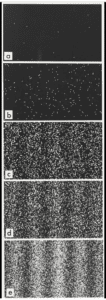
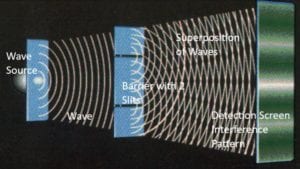
The accompanying photos (left) show this build-up of stripes. Gradually, frame by frame, the dots build up until in Frame (e), the stripes are clearly visible. (It should be noted that this series of photos was created by electrons rather than photons. As the electrons hit, light dots formed on a dark background. But were photons used, a striped pattern would also appear.)
This striped pattern is a signature pattern of waves meeting waves. Waves that meet superimpose themselves upon each other, creating a “superposition.” The image above of two water waves meeting and interfering with each other shows a superposition of waves. Waves in superposition can form the familiar crisscross pattern of two boat wakes meeting or ripples from two pebbles thrown in a pond. The crisscrosses create a striped “interference pattern” on the detection screen.
The interference pattern formed by quantum particles in the Double Slit Experiment is the empirical clue that the photon acts as a superposition of waves prior to detection. The other evidence that the photon acts as a superposition of waves is that the probabilities of its detection are calculated by the wave function. This equation takes a form similar to those which calculate the behavior of water waves, sound waves, and other ordinary waves.
Wave Function Collapse and Schrodinger’s Cat Experiment
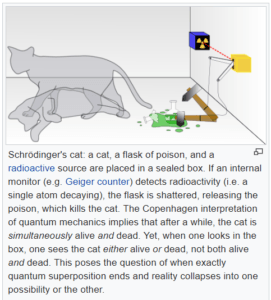
In fact, the mathematics was saying even more. The wave function has a mathematical property called “linearity.” This property means that when the photon superposition interacts with the photographic plate, the superposition should “infect” the photographic plate. The plate, itself, is composed of quantum particles. Mathematically, it appears that the particles in the plate should become correlated with the photon. The plate should go into a superposition like the photon, a superposition of all the positions in which the photon might land.
Instead, the wave function collapses down to a particle, making a single dot on the plate. Rather than going into a blurry superposition, the photographic plate stays solidly in place.
The Schrodinger Cat thought experiment highlights the problem of our ignorance of the cause of the collapse of the wave function. Here’s the experiment: A radioactive atom is in a superposition of two states: 1) decay in which it emits an electron and 2) stability in which it doesn’t. The atom is in a box with a hapless cat and a Geiger counter. If the atom decays and emits the electron, it triggers the Geiger counter, which releases a hammer, which breaks a vial, which releases a poison gas, which kills the cat.
The property of linearity of the wave function tells physicists that the superposition of the atom, both decayed and undecayed, would put the Geiger counter into a superposition of triggered and not triggered. The superposition of the Geiger counter would, in turn, infect the hammer, which would go into a superposition of smashing the vial and not smashing the vial. And so on, until the cat, itself, is in a superposition of being both dead and alive. But this does not describe the reality that we experience. What actually happens in the physical universe that saves us from zombie cats?
Early on, some physicists proposed that consciousness collapses the wave function. Upon the human experimenter looking at it, the entire cat-killing machine is solidified and the cat is found to be either dead or alive but not both. In later decades, the theory of decoherence was developed to explain wave function collapse. Both of these explanations are described below.
It should be noted that some interpretations of quantum mechanics do not hold that the wave function actually collapses. The Many Worlds Interpretation and the de Broglie-Bohm Interpretations are the most well-known of these.
Collapse of the Wave Function and Consciousness
In the 1920’s and 1930’s, some quantum physicists considered the possibility that consciousness collapses the wave function. This possibility is suggested by an odd aspect of the Double Slit Experiment. When the “which path” information is discovered about the quantum particle in any manner whatsoever, the wave function collapses. In other words, if we are able to determine either directly or indirectly the path of the quantum particle through the slits, the waviness of the particle disappears. It becomes a particle.
There’s also a chain of reasoning that raises the possibility that consciousness could play a role in wave function collapse. This reasoning can be illustrated in regard to the Schrodinger’s Cat Experiment: The box in the Schrodinger Cat Experiment might hold a cat which, infected by the superposition of the radioactive atom, is both dead and alive. But we know from experience that when the physicist opens the box and looks, she will see either a live cat or a dead cat, not a blurry superposition of both. Possibly, it is the physicist’s looking, her consciousness, which causes the instantaneous collapse of the wave function to either a live cat or a dead cat.
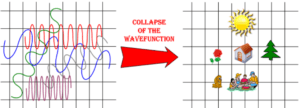
Consciousness and Collapse of the Wave Function—Von Neumann-Wigner Interpretation
In 1932, John Von Neumann, one of the leading mathematicians of the 20th Century, wrote the first comprehensive presentation of the mathematics of quantum mechanics, The Mathematical Foundations of Quantum Mechanics. This became the standard textbook for quantum mechanics. In this volume, Von Neumann proposed that the wave function could collapse at any point in the causal chain from the measurement device to the human perception of the measurement. In the 1960’s, Nobel Laureate Eugene Wigner, proposed that it is, specifically, human consciousness that collapses the wave function. However, in later years, he distanced himself from this proposal.
Noted physicist Henry Stapp, however, continued with the idea that consciousness collapses the wave function. He wrote:
“From the point of view of the mathematics of quantum theory it makes no sense to treat a measuring device as intrinsically different from the collection of atomic constituents that make it up. A device is just another part of the physical universe… Moreover, the conscious thoughts of a human observer ought to be causally connected most directly and immediately to what is happening in his brain, not to what is happening out at some measuring device… Our bodies and brains thus become … parts of the quantum mechanically described physical universe. Treating the entire physical universe in this unified way provides a conceptually simple and logically coherent theoretical foundation….”
The cartoon image above illustrates this view of collapse of the wave function. In this illustration, the universe is a collection of interacting waves which our consciousness collapses down to real solid particles that form houses, trees, the sun, and a family picnic. This view of the role of consciousness in collapsing the wave function is sometimes espoused by people who are into spirituality. They sometimes look back at statements along this line by early quantum physicists like Eugene Wigner and Werner Heisenberg, not realizing that this is no longer mainstream physics. However, some physicists are beginning to consider the possibility that consciousness gives physicality to our universe. Physicists interested in the possibility that we live in a virtual reality may be especially interested in the role of consciousness giving flesh to the equations which govern the universe. For a discussion, see the final section of this article.
Today, most physicists dismiss the idea that consciousness collapses the wave function. Of course, there is no theoretical understanding within physics of consciousness and the mechanics of how consciousness might collapse the wave function. Instead, today (2019), many physicists look to the mathematical theory of decoherence as the explanation or, at least part of the explanation, for the collapse of the wave function. (See next section.) Other physicists subscribe to interpretations of quantum mechanics, such as the Many Worlds and Bohmian Interpretations, which do not involve collapse of the wave function. This, in fact, is one of the main attractions of these two interpretations.
Experimental Results on Consciousness and Collapse of the Wave Function
While many physicists have moved away from considering consciousness as a possible cause of collapse of the wave function, a few physicists have done actual experiments. In addition to other possible causes of collapse, could conscious attention to the path of a quantum particle collapse the wave function? This possibility was investigated by physicists at Princeton University and York University in 1998. Participants were asked to observe with their mind’s eye light traveling through a Double Slit Experimental set-up. The possibility of any physical contact with the set-up was eliminated.
Experimenters at Princeton University used subjects who were experienced with maintaining focused intention in these types of experiments. This experiment found a small but statistically significant effect of visualization on collapsing the wave function. The York University experiment, which used a random group of subjects, did not find a significant effect.
In 2012, a team of parapsychologists, led by Dean Radin, conducted a group of six experiments on consciousness and collapse of the wave function. These experiments found that the results depended heavily on the selection of the subjects. When experienced meditators were asked to see the path of quantum particles in their mind’s eye, wave function collapse was slightly more likely. The results were statistically significant: odds against chance were 107,000 to 1. However, non-meditators were not effective in creating wave function collapse. Results of these studies along with the earlier ones in 1998 were published in peer-reviewed physics journals.
This is an interesting area of research and, hopefully, more experiments will be conducted on the issue.
*M. Ibison and S. Jeffers, “A double slit diffraction experiment to investigate claims of consciousness-related anomalies;” Journal of Scientific Exploration; 1998; 12:543.
** D.I. Radin, L. Michel, K. Galdamez, P. Wendland, R. Rickenbach, A. Delorme, “Consciousness and the double-slit interference pattern: Six experiments;” Physics Essays. 2012:25(2):157-171.
Decoherence and Collapse of the Wave Function
So, what is decoherence? First, I must explain what coherence is. When a quantum particle is in a coherent state, we’re just saying that it’s in a superposition. It’s the wavelike state of the particle that the wave function describes. (Of course, it can be confusing to keep calling it a “particle” when it’s wavelike, but that’s the way physicists speak about it.)
To explain decoherence, let’s return again to the example of the photon moving towards the photographic plate. When it hits the plate, it’s absorbed by an electron in the plate. With this interaction, it’s position is definite. It’s no longer simply a set of possibilities. It has changed things in the physical universe. Information has been created and recorded by the photographic plate. This can’t be undone. The wave function has decohered. Decoherence has occurred.
Starting in the 1950’s, physicists began to realize that they needed to consider the environment that particles were functioning in. In ordinary environments, there are lots of macroscopic particles everywhere. At ordinary atmospheric pressure, so many air molecules float around that the photon need travel only the width of a human hair before bumping into a nearby air molecule. This means that many opportunities are provided quantum particles to decohere and leave the superposition state. For this reason, quantum particle experiments are often conducted within vacuums.
This tendency for a quantum particle to quickly leave its superposition (decohere) is the major barrier in developing useful quantum computers. Quantum computers depend upon the quantum nature of particles–their ability to exist in a superposition. Interactions with the environment bring a quick end to superpositions. Physicists must place quantum particles in containers that prevent the particles from touching the sides of the container. One way is to create magnetic fields which hold electrically-charged particles away from the sides of the container. The containers must also be emptied of air and kept at near-zero temperatures. All of these measures help to prevent decoherence.
This is an area of active research. Physicists are doing experiments and developing the math so as to better understand the interactions between quantum particles and the environment. A 2013 experiment on the interactions of photons with atoms is a good example. Both atoms and photons have the quantum property of spin. The spin of a photon can either be aligned with the spin of an atom that it encounters or not aligned. The experimenters found that if the spin of the photon is aligned with the spin of the atom, the two will not interact; the wave function of the photon will not collapse. It will remain in a superposition. However, if the spin of the photon and the atom are aligned, they will interact. The wave function will collapse, and the photon will have lost its superposition and been measured. It will experience decoherence.
The collapse of the wave function is a central problem which physicists continue to explore. It has become a problem with important implications due to its role as a major barrier to the development of quantum computing.
Another Role for Consciousness in Physics
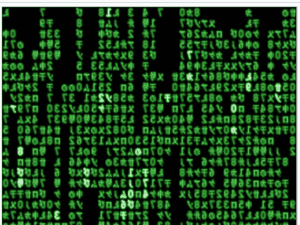
The entire universe might be seen as interacting equations, one equation’s output providing the input for another equation, and so on. Continuing the process of the photon being absorbed by an electron in the photographic plate, an entire chain of equations govern the interactions which end with equations for electromagnetic waves in the brain of the physicist who looks at the photographic plate. These electromagnetic waves describe a dark spot on the photographic plate. But how do we get get from these equations describing electromagnetic waves in the brain to the physicist having the subjective experience of seeing a dark spot? This is where consciousness comes in. The consciousness of the physicist decodes the equations and provides the experience of seeing a dark spot.
Rather than focusing on equations, we might see the universe as the “computer code” that the equations generate. This is the world that the enslaved humans in the movie “The Matrix” live in. They live in a virtual reality, essentially an interactive video game, created by computers which their brains are hooked into. However, this view of reality doesn’t necessarily imply that we are characters in a computer video game. Physicists like Amit Goswami have proposed instead that the coding is in one mind that we are all hooked into.
